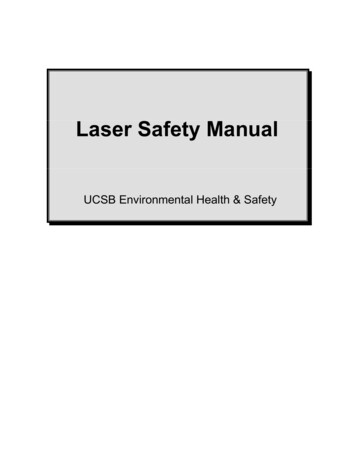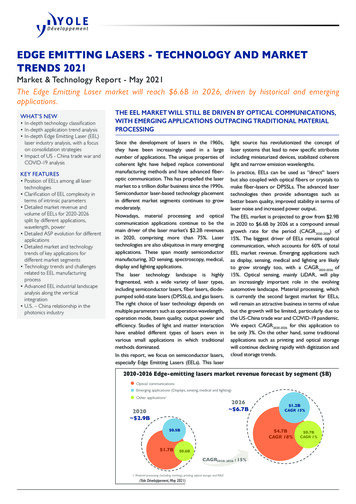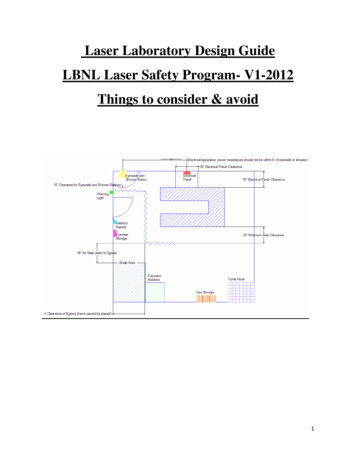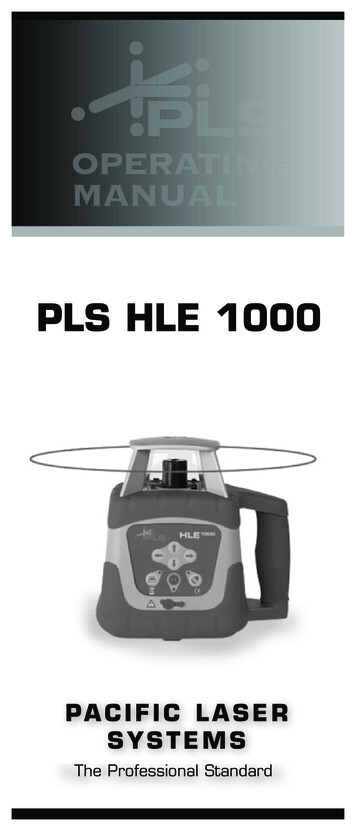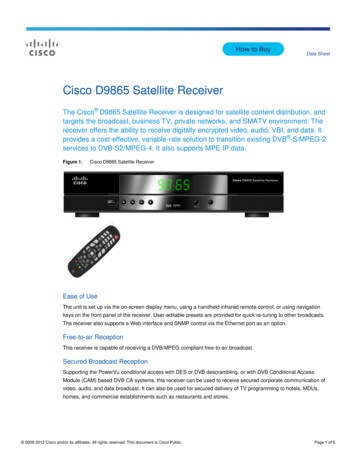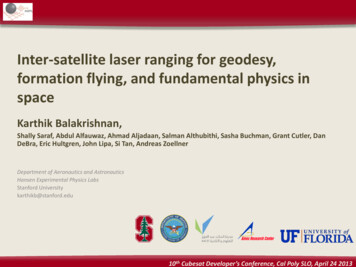
Transcription
Inter-satellite laser ranging for geodesy,formation flying, and fundamental physics inspaceKarthik Balakrishnan,Shally Saraf, Abdul Alfauwaz, Ahmad Aljadaan, Salman Althubithi, Sasha Buchman, Grant Cutler, DanDeBra, Eric Hultgren, John Lipa, Si Tan, Andreas ZoellnerDepartment of Aeronautics and AstronauticsHansen Experimental Physics LabsStanford Universitykarthikb@stanford.edu10th Cubesat Developer’s Conference, Cal Poly SLO, April 24 2013
Outline Ranging and formation missions – required range Ranging architecture comparison – retro-reflector vs. activetransponder System architecture Comparison to full-size missions MGRS – Stanford’s drag-free implementation Small satellite ranging-precursor missions at Stanford– UV-LED (2013)– Caging on zero-g (2013) (3u)– DOSS (2014) (2u)– Drag-free cubesat (2015) (3u)10th Cubesat Developer’s Conference, Cal Poly SLO, April 24 2013
Ranging Missions Low unit cost for Cubesats make them an attractive choice for formation-flying missionsHow do we increase the position accuracy towards that of larger ranging missions?NameTypePosition accuracyLISARanging10 pmGRACE (non-laser)Ranging2 umGRACE-IIRanging50 nmDTUsat (non-laser)Formation, cubesat1 mmCanX-4/5 (non-laser)Formation, cubesat10 cm10th Cubesat Developer’s Conference, Cal Poly SLO, April 24 2013
Architectures: Retro-Reflector vs. TransponderNd:YAG Laser(Free running)Nd:YAG Laser 1(Free running)Remote S/C90:10 Beam SplitterOutbound BeamTelescope 1Nd:YAG Laser 1(Free running)Telescope 1Telescope 2Reflected BeamPhotodiode Single 1064 nm laser on master satellite Remote satellite has a corner cube reflector Ranging data measured on master satelliteFor a 200km separation: Poptical at detector 1.5 nW-2TransponderRetro-reflector-4Outbound BeamReflected BeamPhotodiodeTelescope 2Optical power at master satellite receiver vs. inter-satellite range1050:50 Beam SplitterTelescope 3foffsetSingle 1064 nm laser on master satellite Remote satellite has a corner cube reflector Ranging data measured on master satellite90:10 Beam SplitterTelescope 4Nd:YAG Laser(Free running) Recieved optical power (W) Offset lockingw/ oscillatorPhasemeterPhasemeterRemote S/CTelescope 110-610-810-1010-1210Phasemeter Can use a single master satellite with severalremote satellites in formation by dividing beam 0100P0 – outbound powerw0 – aperture radiusz – rangezR – Rayleigh length200300Intersatellite range (km)𝑃𝑃 400500𝑟𝑟2𝑃𝑃0 2𝑧𝑧𝑤𝑤 1 2𝜋𝜋𝜋𝜋 𝑒𝑒𝜋𝜋 0𝑧𝑧𝑅𝑅 02𝑟𝑟 2 𝑧𝑧𝑟𝑟 1 𝑧𝑧𝑅𝑅𝑑𝑑𝑑𝑑10th Cubesat Developer’s Conference, Cal Poly SLO, April 24 2013
Spacecraft ConfigurationsRemote SpacecraftMaster SpacecraftCorner cubePrimary mirrorLEDLaserPhase meterPhoto detectorSecondary mirror Laser and telescope assembly: 1 to 1.5 U Space available to add ADCS, or cavity toimprove laser frequency stability Corner cube assy. takes 1/4 U Remainder of s/c is available forpayload use including ADACS andthrusters LEDs and PDs for initial beamacquisition and alignment10th Cubesat Developer’s Conference, Cal Poly SLO, April 24 2013
CubeSat vs. Full-Size ArchitectureGRACE-IIE-LISA MissionStanford Ranging ArchitectureLISA-likeGRACE-IICubesat-basedLaser source1064 nm stabilized1064 nm stabilized1064 nm free runningOutput power2W30 mW10-20 mWOne-way received power360 pW2000 pW1500 pWAperture diameter38 cm1.5 cm2 cmS/C to S/C Distance5x106 km200 km100-200 kmOrbit Control SystemDrag freePossible drag freeDrag free (with MGRS)Range-locked (formation)10th Cubesat Developer’s Conference, Cal Poly SLO, April 24 2013
Doppler and Laser Frequency NoiseDominant error source is relative velocity between s/c – Doppler term 𝑓𝑓𝐷𝐷 Ultimately requires laser source on each s/c to deal with the Doppler problem–Use of a free-running laser: second dominant noise source 𝟏𝟏𝟏𝟏 𝝁𝝁𝝁𝝁 at 200 km range@1Hz frequency–Frequency noise spectrum of NPRO laser, 1064 nm1010Pathlength error due to laser frequency noise, P m 10mW, f 1 Hz-410Free RunningCavity StabilizedTransponderRetro-reflector810-5Frequency noise (Hz/rtHz) 𝑣𝑣𝐷𝐷𝜆𝜆2 m/s 𝑣𝑣𝐷𝐷 results in 2 MHz shift in 𝑓𝑓𝑙𝑙𝑙𝑙𝑙𝑙𝑙𝑙𝑙𝑙 resolution limited to 1 mm at 200 km range!A few ways around this Time domain interferometry, used for LISA [11],[12] Offset phase-locked transponder, proposed for GRACE-II: �𝑒𝑒𝑒𝑒𝑒𝑒𝑒𝑒 ��𝑡𝑡𝑡𝑡𝑡𝑡𝑡𝑡𝑡𝑡𝑡 2𝑓𝑓𝐷𝐷 [8]––Best measureable range (m) 0050100150200250300350Intersatellite range (km)40045050010th Cubesat Developer’s Conference, Cal Poly SLO, April 24 2013
Secondary Noise Sources Other noise sources: USO, TDI algorithm residuals, shot noise –𝑑𝑑𝜙𝜙𝑠𝑠𝑠𝑠𝑠𝑠𝑠 �𝑈𝑈𝑈𝑈𝑈𝑈 121 𝑠 𝑑𝑑𝜙𝜙𝑠𝑠𝑠𝑠𝑠𝑠𝑠 ��𝑏 [REFERENCE EQUATION HERE] By stabilizing the laser with a cavity, USO and TDI residuals becomedominant – ranging improves to nm rangeFree running laser best performance, f 1Hz, P 10mW-4Cavity stabilized laser best performance, f 1Hz, P ro-reflector-9Best measureable range (m)Best measureable range 00350Intersatellite range (km)40045050010050100150200250300350Intersatellite range (km)40045050010th Cubesat Developer’s Conference, Cal Poly SLO, April 24 2013
MGRS: simplified for smallsatsDrag-free error budgetSpinningspherical Test MassHousing(metrology reference)10th Cubesat Developer’s Conference, Cal Poly SLO, April 24 2013
UV LED Small Sat DemonstrationCharge Amp2.52Sphere Potential1.510.50-0.5-1-1.510203040Time (minutes)5060Scheduled for launch in Nov. 201310th Cubesat Developer’s Conference, Cal Poly SLO, April 24 2013
DOSS Sat 2U CubeSat Raise Shadow Sensor TRL Test attitude controlalgorithms Completion: Late 2013Previous setup (in-air)1nmCourtesy A. Zoellner10th Cubesat Developer’s Conference, Cal Poly SLO, April 24 2013
Proof Mass Caging SystemClamp proof mass during launch with 200 N force13.5:1 gear ratioCurrently being tested on NASA Zero-G (Eric and Andreas are in Houston right now!)34 cm Courtesy E. Hultgren, A. Zoellner10th Cubesat Developer’s Conference, Cal Poly SLO, April 24 2013
Drag Free Cubesat 3U CubeSatFull MGRS demoCompletion: mid 2015Research goals:– Drag-free control algorithm– On-orbit performance evaluation of MGRS– Performance goal: 10–12 m/sec2Hz1/2 (for geodesy)Courtesy A. Zoellner10th Cubesat Developer’s Conference, Cal Poly SLO, April 24 2013
Questions?1.2.3.4.5.6.7.8.9.10.11.12.13.14.B. Lange. “The Control and use of Drag-free Satellites”. PhD thesis, Stanford University, 1964.D. B. DeBra and J. W. Conklin. “Measurement of drag and its cancellation”. Classical and Quantum Gravity, 28(9):094015,May 2011.Ke-Xun Sun, Saps Buchman, Robert Byer, Dan DeBra, John Goebel, Graham Allen, John W Conklin, Domenico Gerardi, SeiHiguchi, Nick Leindecker, Patrick Lu, Aaron Swank, Edgar Torres, and Martin Trittler. “Modular gravitational reference sensordevelopment”. Journal of Physics: Conference Series, 154:012026, 2009.K. Balakrishnan, E. Hultgren, J. Goebel, and K.-X. Sun. “Space Qualification Test Results of Deep UV LEDs for AC ChargeManagement”. In 11th Spacecraft Charging Technology Conference, poster presentation, September 2011.Numata, K., Camp, J., Krainak, M. A., & Stolpner, L. (2010). Performance of planar-waveguide external cavity laser forprecision measurements. Optics Express, 18(22), 22781. doi:10.1364/OE.18.022781Jeganathan, M., & Dubovitsky, S. (2005). Demonstration of nm-level Active Metrology for Long Range InterferometricDisplacement Measurements, (818).Robertson, D., & Hough, J. (1996). Interferometry for LISA. Classical and Quantum Gravity, 13(11A), A271–A277. Cruz, J. I.,Thorpe, R. J., Mueller, G., Cruz, R. J., Thorpe, J. I., & Mueller, G. (2005). Laser Interferometer Space Antenna Simulator. LaserPhysics, 15(7), 1056–1061.Sheard, B. S., Heinzel, G., Danzmann, K., Shaddock, D. A., Klipstein, W. M., & Folkner, W. M. (2012). Intersatellite laser ranginginstrument for the GRACE follow-on mission. Journal of Geodesy, 86(12), 1083–1095. doi:10.1007/s00190-012-0566-3Diekmann, C., Steier, F., Sheard, B., Heinzel, G., & Danzmann, K. (2009). Analog phase lock between two lasers at LISA powerlevels. Journal of Physics: Conference Series, 154, 012020. doi:10.1088/1742-6596/154/1/012020McNamara, P. W. (2005). Weak-light phase locking for LISA. Classical and Quantum Gravity, 22(10), S243–S247.Thorpe, J. I., Maghami, P., & Livas, J. (2011). Time Domain Simulations of Arm Locking in LISA. General Relativity andQuantum Cosmology; Instrumentation and Methods for Astrophysics. doi:10.1103/PhysRevD.83.122002Tinto, M., & Dhurandhar, S. V. (2005). Time-Delay Interferometry. Living Reviews in Relativity, 8. doi:10.12942/lrr-2005-4Astrium. (2009). LISA Requirements Breakdown.Heinzel, G. (2010). LISA technology for other missions LISA Design Features. Gravitational-Wave Advanced DetectorWorkshop. Kyoto, Japan.10th Cubesat Developer’s Conference, Cal Poly SLO, April 24 2013
10th Cubesat Developer's Conference, Cal Poly SLO, April 24 2013 Inter-satellite laser ranging for geodesy, formation flying, and fundamental physics in space. Karthik Balakrishnan, Shally Saraf, Abdul Alfauwaz, Ahmad Aljadaan, Salman Althubithi, Sasha Buchman, Grant Cutler, Dan

